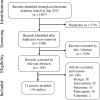Improving CSF Biomarkers' Performance for Predicting Progression from Mild Cognitive Impairment to Alzheimer's Disease by Considering Different Confounding Factors: A Meta-Analysis
- PMID: 25360114
- PMCID: PMC4199277
- DOI: 10.3389/fnagi.2014.00287
Improving CSF Biomarkers' Performance for Predicting Progression from Mild Cognitive Impairment to Alzheimer's Disease by Considering Different Confounding Factors: A Meta-Analysis
Abstract
Background: Cerebrospinal fluid (CSF) biomarkers' performance for predicting conversion from mild cognitive impairment (MCI) to Alzheimer's disease (AD) is still suboptimal.
Objective: By considering several confounding factors we aimed to identify in which situations these CSF biomarkers can be useful.
Data sources: A systematic review was conducted on MEDLINE, PreMedline, EMBASE, PsycInfo, CINAHL, Cochrane, and CRD (1990-2013).
Eligibility criteria: (1) Prospective studies of CSF biomarkers' performance for predicting conversion from MCI to AD/dementia; (2) inclusion of Aβ42 and T-tau and/or p-tau. Several meta-analyses were performed.
Results: Aβ42/p-tau ratio had high capacity to predict conversion to AD in MCI patients younger than 70 years. The p-tau had high capacity to identify MCI cases converting to AD in ≤24 months.
Conclusions: Explaining how different confounding factors influence CSF biomarkers' predictive performance is mandatory to elaborate a definitive map of situations, where these CSF biomarkers are useful both in clinics and research.
Keywords: Alzheimer’s disease; CSF biomarkers; confounding factors; meta-analysis; mild cognitive impairment; systematic review.
Figures


References
-
- Albert M. S., DeKosky S. T., Dickson D., Dubois B., Feldman H. H., Fox N. C., et al. (2011). The diagnosis of mild cognitive impairment due to Alzheimer’s disease: recommendations from the National Institute on Aging-Alzheimer’s Association workgroups on diagnostic guidelines for Alzheimer’s disease. Alzheimers Dement. 7, 270–279.10.1016/j.jalz.2011.03.008 - DOI - PMC - PubMed
Publication types
LinkOut - more resources
Full Text Sources
Other Literature Sources

